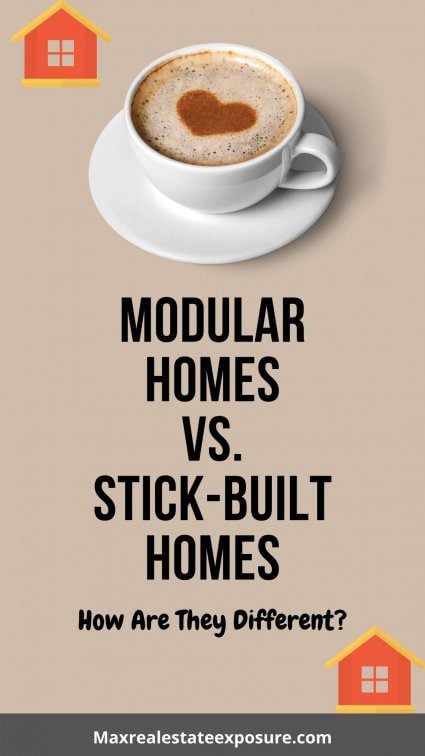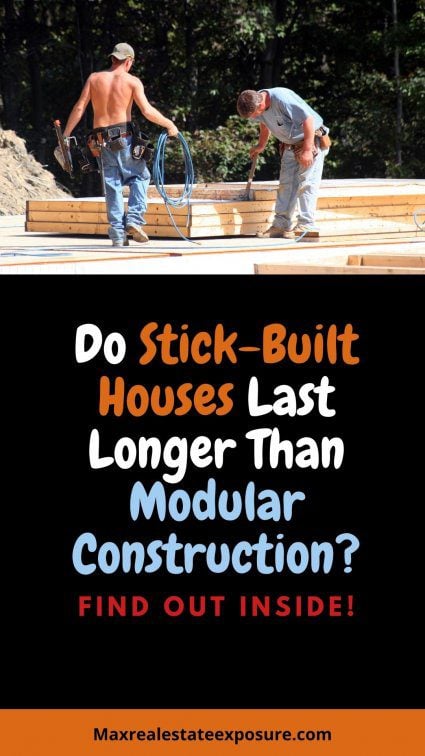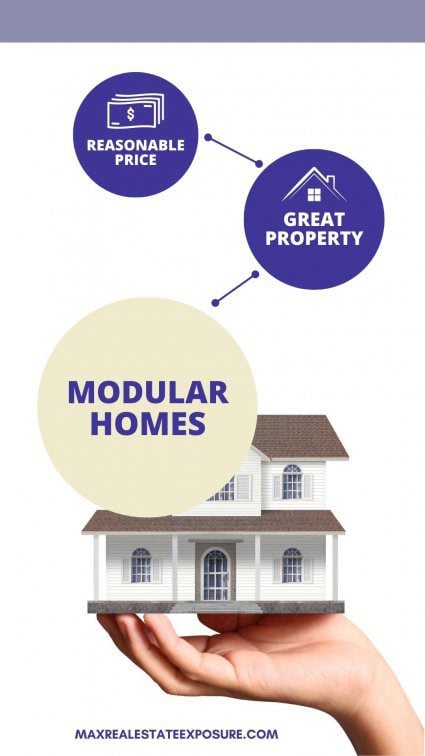 When you buy a home or have new construction built, you have lots of choices to make. It can be a confusing experience with new terms to understand and decide on. One such decision is the type of home to choose from.
When you buy a home or have new construction built, you have lots of choices to make. It can be a confusing experience with new terms to understand and decide on. One such decision is the type of home to choose from.
A standard comparison is modular homes versus stick built.
While you might not have heard of these different terms before, they could be significant in your home buying decision-making.
We’ll compare stick-built vs. modular homes and what you need to consider when you choose between the two.
It should be noted right off the bat that mobile homes are not the same things as modular homes. Many folks also confuse the term manufactured home with a modular house. We will cover the differences as well with these types of homes.
Modular housing is also referred to as prefab homes. So, if you hear someone referring to a property as a prefab, it’s modular construction.
Home buyers should understand the building process before deciding which new home option is the best.
Modular Homes Versus Stick Built: How Are They Different?
The main difference between a stick-built home vs. modular is how they are constructed. Stick-built homes are built on-site, which doesn’t necessarily mean that they are made using sticks.
Any building materials can be used, but the property will still be considered stick-built.
Stick-built construction is sometimes referred to as site built or on-site and is a more traditional method to build a home. The stick-built term comes from the fact builders would assemble the property one stick at a time on the home site.
Modular homes differ in that they are constructed in the factory in sections. They are then transported to the lot to be fitted together on the foundations. Three-dimensional sections might require a crane to lift them off the truck and into their position in the construction.
In the case of a stick-built home, the property is built onto a permanent foundation, whereas the modular home is loaded onto it.
How Are Modular Homes Built?
The modular sections of the home will contain the majority of the crucial parts of the structure. This will include windows, insulation, electrical cabling, and HVAC systems already in place before the modular sections leave the factory. The contractor will assemble the parts correctly and finish the property.
Modular homes have been popular for over 100 years to answer rapidly growing populations in the United States. The government also used modular properties to house returning soldiers from both world wars, but the technology and scope of this type of home have improved a lot since then.
When you first hear about modular homes, you might picture World War II prefabricated buildings, but the modern reality of this type of housing has moved on considerably. Technologies like AI and 3D printing are now used to improve modular homes and their affordability.
On the other hand, stick-built homes are a more traditional construction method. If large sections of the home aren’t constructed off-site, it is a stick-built property.
Even if the home isn’t using sticks or much wood in the construction, it is still considered a stick-built property.
Are Modular Homes Cheaper Than Stick Built?
 Of course, the price of a home will depend a lot on the size, the style, and the materials used. There is also a big difference between new construction and buying an already built modular home.
Of course, the price of a home will depend a lot on the size, the style, and the materials used. There is also a big difference between new construction and buying an already built modular home.
On a price-per-square-foot basis, modular homes are typically cheaper to build. The factories that produce modular homes are specialized, with their construction costs reduced and production processes streamlined.
These savings naturally get passed on to the buyer, making a modular home a good value option.
Things are different when you buy a modular home, where you are less likely to notice a difference from a stick-built one.
Differences between the design and the quality of the house should be considered and how common this type of construction is in the neighborhood.
Typically, the value of modular homes will hold up better in communities where there are more of them.
The perceived value of modular homes can also be an issue for homeowners’ associations. The rejection can sometimes be given as the reason why an HOA does not allow them in their community.
Along with these factors, of course, the property’s condition is essential. A modular and a stick-built home could be the same size, but if one of them is in a substantially worse situation, that will have a more significant effect on the value than anything else.
Are Modular Homes Faster to Build?
Assembling the modular sections on the lot is a faster process than building a traditional home. However, it would be best to remember that the foundations need to be poured before the sections are delivered.
You also need to wait for that delivery to take place, and there’s still the finishing along with the utility hookups before the project is completed.
With modular construction, there is less of a chance of delays due to adverse weather than stick-built homes. All of these things lead to a faster build time for modular homes. It can take less than four months once construction begins from start to finish.
It also means that your builders won’t have to make as many decisions during construction, and they’ll spend far less time on the construction site as well. This will save money on the build cost, and less time allows for fewer problems from weather and other potential issues.
There are Fewer Weather Delays With Prefab Houses
Homebuilders don’t have to worry about weather delays like you might find in some parts of the country with snowstorms and frigid temperatures. Being in a controlled environment makes the building process go far more smoothly. The weather conditions outside won’t slow down the construction of a prefab home for a modular home builder.
However, sometimes there are advantages to a longer build time.
With a home that takes longer to put together, the homeowner can see the project progress and realize some things need to be altered. Perhaps once construction begins, the buyer will recognize that they need a door in a different wall or would like to increase the size of a room.
Even though this is likely to add to the construction cost, making these changes is something you can do when the home hasn’t been prefabricated in a factory.
In modular home construction, you might be able to alter the original design after construction, but this will be limited. You can, of course, make changes later on, but this will be far more costly.
Do Stick Built Homes Last Longer Than Modular Construction?
 In theory, there shouldn’t be a difference in the longevity of these different types of construction. This is because they both have to follow the same building codes.
In theory, there shouldn’t be a difference in the longevity of these different types of construction. This is because they both have to follow the same building codes.
The building codes should ensure the same quality between stick-built and modular. They’ll have comparable roof integrity, and plumbing and electrical systems should be of the same quality to match stick-built homes.
Even though modular homes are constructed in a factory, the building code still applies. It could even be argued that the modular construction process could allow for higher-quality buildings.
Since the assembly of the sections takes place indoors, it isn’t going to be damaged by rain or frost during construction. You would also expect better quality control in factory assembly conditions.
However, despite these potential benefits to modular construction, the quality and longevity of the home will depend on the company making the modular sections.
Unfortunately, some companies are better than others when manufacturing modular homes. So it is vital to make sure you carefully choose the company that will be manufacturing your new modular home.
Is Home Insurance More Costly For Modular Homes?
Which type of property you choose should not affect your home insurance premiums. You will often find that insurers do not even ask whether the home is modular or stick-built when you apply.
Premiums are the same because there isn’t more risk when comparing a stick-built home vs. modular. There shouldn’t be any difference in the quality of the property or anything that will increase damage to the house. The bottom line is you can apply for the same insurance coverage for either property type.
Modular homes are also no more expensive to repair than stick build homes. This is another reason why insurance isn’t going to be more costly. And if you want to remodel or have additions built, it isn’t going to be any more difficult or expensive with a modular home over a stick-built one.
Is Financing Different in a Stick-Built vs. Modular Home?
There should be no difference in financing options with either home type. A traditional mortgage should be okay with either type of housing. Lenders will be more concerned about the property’s value, which they will check via a property appraisal.
Appraisers will be using the quality of construction in their evaluation. In recent years, the resale value of modular homes has been similar to stick-built. For many years traditional houses were seen as far superior construction. That is no longer the case.
If you own an older modular home, there could be differences in quality compared to a traditional home. Years ago, the design features and quality of construction were inferior to prefab housing.
An astute appraiser will notice deficiencies and functional obsolescence when looking at comparable sales data.
Financing When Contracting Your Own Modular House
If you want to buy your piece of land and custom build a modular home yourself, the two financing options will be a land loan and a house building loan. If you are not building right away, a loan for the land will be the best option.
When you plan on starting building immediately, the best choice will be a construction loan.Click To TweetStick-Built vs. Modular Homes When it Comes to Customization
If you need unique customization for your property or the designs available aren’t exactly what you’re looking for, making changes can be more difficult with modular designs. There may be fewer floor plans as fewer architects draw prefab houses.
While choosing different options for a modular home will be possible, up to a point, more significant changes might be more of a problem. There are fewer custom homes with modular construction.
Since the factory is set up to construct specific modular designs, more extensive changes may not be allowed. If you want to make substantial changes to the modular designs offered, a stick-built home may be a better choice.
With a stick-built home, you only need to ask the architect to alter the design. Then the changes shouldn’t be a problem for your builder to meet, though the final bill for the project is likely to change as well.
How is a Modular Home Different From a Manufactured Home?
The primary difference between modular homes and manufactured houses is that modular are built according to local and state building codes. On the other hand, a manufactured home is made according to the National HUD code.
The HUD code is building standards set forth by the US Department of Housing and Urban Development.
Modular homes share similarities with traditional houses in that local building codes can dictate how the home is constructed. For example, the foundation may have specific requirements, or the roof pitch may need a certain height.
Both modular and manufactured homes are built in a factory setting.
 Advantages of a Modular Home
Advantages of a Modular Home
The benefits of modular homes are as follows:
- Modular homes have higher quality now than in years past.
- The modular home cost is usually less than stick-built housing.
- Modular construction has energy efficiency.
- Construction of a modular home is built in a climate-controlled factory setting.
- Modular housing can be constructed in lousy weather, saving construction time.
Disadvantages of a Modular Home
The cons of modular homes are as follows:
- Older modular construction has inferior quality vs. stick-built properties.
- Curb appeal on older modular properties was lacking with low-pitched roofs.
- There are fewer floor plans.
- Prefab construction has more minor customization.
- There are far fewer modular home builders.
- Some homeowners’ associations may not allow modular construction within the neighborhood.
When Buying Traditional Homes or Modular Construction Get it Inspected
Whether buying a traditional stick-built or a prefab home, it makes sense to check the quality of construction. You should hire a professional home inspector to perform a house inspection on either housing choice.
A buyer or even a real estate agent may question the need to have a home inspection. Unfortunately, not every home builder follows the best construction methods. Some home builders have higher standards than others.
By having a home inspection, you can have peace of mind that safety standards were followed. While new construction, whether modular or traditional stick-built, should follow local building codes, sometimes things are missed.
While there are no mandatory home inspection fixes unless the problem prevents the builder from getting an occupant permit, it can help create a punch list.
When interviewing either a modular home builder or a traditional one, make sure you ask many home building questions.
Final Thoughts on Modular Homes versus Stick Built
Homes are generally the most prominent investment any of us ever make, but many of the terms used can be confusing. To make sure you choose the right property, it is essential to understand these terms.
Modular homes offer advantages in some ways ahead of stick-built properties, but there are some situations where the more traditional construction will be better. Whichever type you choose for new construction, there aren’t going to be any noticeable differences when the home is completed.
When comparing stick-built homes vs. modular homes, know which essential factors will make the most significant difference for you. Hopefully, you can now make an informed decision with these two choices.
What might be a better option for you may different for others.
About the author: The above Real Estate information on modular homes vs. stick-built homes was provided by Bill Gassett, a Nationally recognized leader in his field. Bill can be reached via email at billgassett@remaxexec.com or by phone at 508-625-0191. Bill has helped people move in and out of many Metrowest towns for 35+ years.
Are you thinking of selling your home? I have a passion for Real Estate and love to share my marketing expertise!
I service Real Estate Sales in the following Metrowest MA towns: Ashland, Bellingham, Douglas, Framingham, Franklin, Grafton, Holliston, Hopkinton, Hopedale, Medway, Mendon, Milford, Millbury, Millville, Natick, Northborough, Northbridge, Shrewsbury, Southborough, Sutton, Wayland, Westborough, Whitinsville, Worcester, Upton, and Uxbridge MA.


 Advantages of a Modular Home
Advantages of a Modular Home